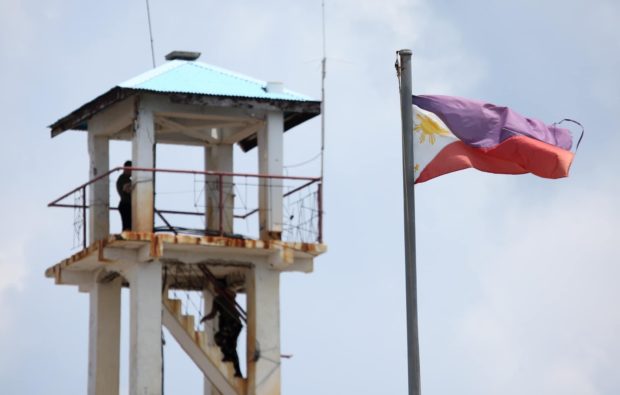MANILA, Philippines—The Armed Forces of the Philippines (AFP) was “entertaining the idea” of building structures in the West Philippine Sea to assert Philippine sovereignty in the area similar to what China does to enforce its invalidated territorial claims, according to AFP chief Gen. Cirilito Sobejana.
At a press briefing on Thursday (April 22), Sobejana said the proposal had been sent to the National Task Force in the West Philippine Sea (NTF-WPS), an inter-agency body led by Malacanang, for its consideration.
“We are already looking for ways how to strengthen our position in that part of our country,” Sobejana said, referring to the West Philippine Sea as part of the Philippines but under siege by China’s aggressive push to grab territory.
“We are entertaining the idea, subject to the wisdom of NTF-WPS, of building structures in those areas like what China is doing,” Sobejana said.
The AFP chief appeared to be aware of a ban on building and occupying features in the South China Sea (SCS), which includes WPS, which was stipulated by the 2002 Declaration on Conduct of Parties in the South China Sea. Countries with claims to SCS had agreed through the declaration to use peaceful means to settle conflicts to prevent regional instability.
“The reason we are not building there is because we have an agreement that no one should build and that was violated by China,” Sobejana said. “So we will build starting now. That is subject to the NTF-WPS,” he said.
The NTF-WPS is chaired by National Security Adviser Hermogenes Esperon Jr. but gets guidance from President Rodrigo Duterte, who had said the only way Chinese intruders in WPS could be removed from the area is through force.
Sobejana said going to war, though, is the last resort, and the AFP will keep looking for means to assert Philippine sovereignty in WPS peacefully.
This appeared to run counter to Duterte’s statement that asserting Philippine sovereignty in WPS would lead to bloodshed.
Retired Supreme Court Senior Associate Justice Antonio Carpio recently urged the Philippine government to build structures within the Philippines’ exclusive economic zone (EEZ) which is in WPS.
“The arbitral award says we have an EEZ and within the EEZ, only the coastal state, the Philippines, can put up structures, artificial structures and we have to exercise that right,” he said in a television interview.
Carpio said the Philippines can build on features within the EEZ that are submerged at high tide because the arbitral award ruled that those waters belonged to the Philippines.
The 2002 declaration of conduct, according to Carpio, barred the building of structures in uninhabited features in the SCS “but we should interpret this to mean that territorial dispute, to refer to the territorial dispute, to features that are above water at high tide.”
“If they were unoccupied in 2002, you cannot occupy them now,” Carpio said.
“But with respect to the EEZ which are submerged at high tide, the tribunal said, those are EEZ, and under UNCLOS it is only the Philippines that can put up an artificial structure, so we should take advantage of that,” he said, referring to the United Nations Convention on the Law of the Sea.
“Otherwise, China will beat us. China will just put up something there, and there’s nothing we can do. We should put up structures within our EEZ,” he said.
China’s mythical nine-dash claim to the majority of the South China Sea, including the West Philippine Sea, was ruled null and unfounded by an international arbitral tribunal in The Hague in 2016. China, the ruling said, violated Philippine sovereignty and the right of Filipinos to fish and explore in the West Philippine Sea. Beijing regards the ruling as a waste of time and does not recognize it.
